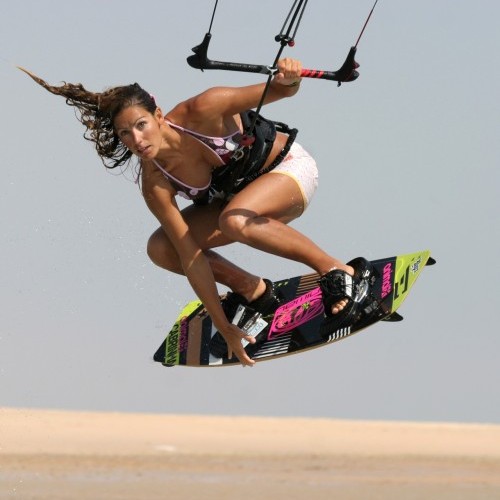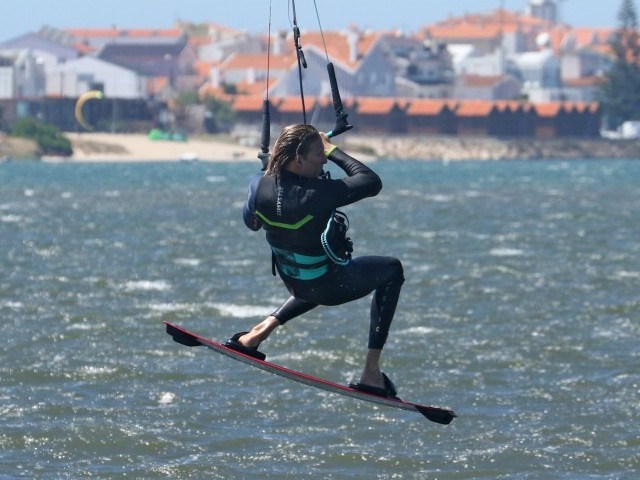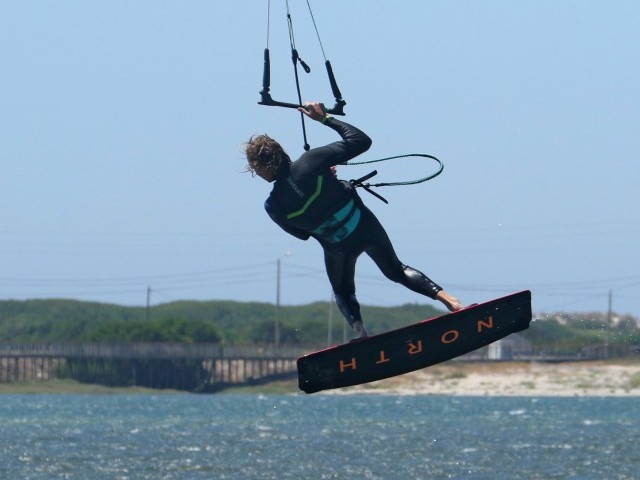
Popped Indy Grab
Technique / Intermediate
Introduction
Continuing on from last issue’s popping off a wave, we thought you’ve probably had enough practice, have potentially evolved it into a decent flat water spring, and therefore need that certain je ne sais quoi to spice things up a bit. The basic ingredient and first port of call when adding style to any move has to be a cheeky grab. Title for the easiest of the more tasty looking pop grabs goes to the Indy, Video 1, so that’s your mission should you choose to accept it.
Simples
If you’re not the world’s most accomplished grabber yet, try starting off with the following a few simple run throughs which will help you realise that you don’t need to a contortionist to reach your board.
Firstly get your bum parked firmly on dry land, could be the beach, the garden or the sofa, and your board wedged onto your feet. Try going for a tail grab with your back hand just behind your back on the heelside rail. If you can’t reach it, rather than blame Christmas, try bringing your knees up to your chest as you bend forward and reach down with your hand. This should be very achievable, unless you’re fonder of your Guinness than your kiting.
Now try the same but going for an Indy grab. The basic idea of an Indy grab is to grab the toeside of your board with your back hand in between your feet. Apparently if you play a lot of Tony Hawk you’ll think that any toe side grab is an Indy, but then again if you do you’re probably not going to be reading this. And to further confuse matters if you grab just in front of your back foot on the toeside edge with your back hand you are performing a Tindy grab.
Running through this on land will get the body dialled in to what you want it to do, so it’ll be a lot easier on the water when time is limited.
Secondly try going for these grabs during sent kite jumps, as you’ll get a lot more time to execute them, hone them, and then translate them to your pop. A grab that you cannot do during a jump will be a lot harder to learn straight from pop.
Popping
Hopefully during your popping practice you have got to grips with keeping both hands on the bar, and only releasing you rear hand for balance. If you still find that you are prone to taking the front hand off when you feel unstable, you’ll need to iron that out by taking the back hand off. The best way to force the back hand off is to go for a tail grab, as it’s the nearest grab to tour hand and you’re most likely to know this one from jumping. In Sequence 1. you can see Karine doing this, and it looks exactly the same as if she did it of a sent jump. Give it a go.
Some Pointers
If we ponder over a few key stages of a popped grab it will give a good picture of what needs concentrating on.
In Pic A. Karine is just launching up and off the water. Her legs are fully extended as she takes off, so even though she’s going for a grab she has not cut corners by mellowing down her pop in order to get her knees up quicker. Rather she is popping hard to give herself the time to grab. With the tail of the board still in contact with the water she has already released her back hand, as this leads the entire grab movement. Think where the hand goes the body will follow! Karine needs both hands on the bar to carve and pop but once her energy moves upwards she can release her back hand. This is only possible if she has her front hand centred on the bar.
Pic B. following her take off, Karine is now going for an Indy grab. To give herself more room to work in Karine has turned her shoulders away from the bar as if she were looking slightly behind her. You can see how she has brought her knees up as far as possible and then has folded her upper body down to allow her to reach the board. The key is to use both halves of you, one comes up and the other comes down. Karine has also lifted her toes, almost curling them towards her shins, which lifts the toeside edge of the board a considerable amount. Looking at the bar you can see that Karine has let the bar slip up and away from her. Like this the kite is not pulling her forwards and off balance, and even more importantly the chicken loop is not holding her body up, so she can bend down. Finally Karine has her knees pointing outwards, which gives her room to drop her shoulder in between her legs and reach down for the edge. This is crucial. It is quite possible that as many of you bend your knees they will come together, if you are tall and gangly even more so. Concentrating on that teenager snowboard stance with your knees pointing out could be the difference between getting the grab and not.
Pic C. shows Karine dropping down for landing. There are many similarities with a fast jump landing. Karine is pointing off the wind, so she can land on a flat board, and therefore keep her balance even at speed. She is coming down tail first, which will soften the landing considerably. She still has her back hand off the bar, which she uses to balance herself much as any other board rider would. And finally Karine is still compressed and ready for the landing. She doesn’t need to be upright so long as her weight is over the board and not to one side or other. This means that she doesn’t need a huger amount of time in the air for her pop, as her grab position leads nicely into her landing position. Karine releases her grab and lets her legs drop slightly just before touch down.
Don’t Forget the Basics
It is very easy to get all excited about what you are about to do and forget the base as you concentrate on what’s to come. As popping is everything, get your pop going by rattling off a few ungrabbed ones first. Make sure that you are popping hard and with enough speed. As tempting as it is to be gentle, all the “things” which can seem so wrong, speed, lowish kite, height, these all help to make the grab so much easier.
Following Sequence 2
Pic 1. With her kite no higher than 11 o’clock, Karine has checked she has space, looked for a bit of flat water and has accelerated off the wind towards it. As for a pop she has then carved hard upwind, resisting with her weight dropped over her back foot, hands centred on the bar and then exploded upwards off her back leg. As soon as she pushes up Karine looks down to where she wants to grab and releases her back hand.
Pic 2. Karine lifts her knees and the board up towards her, making sure that her knees are pointing outwards over her toes, whilst reaching down with her back hand. Karine turns her head back to lead her shoulders away from the bar.
Pic 3. With the bar held away in front of her, Karine has room to bend down towards the board, dropping her trailing shoulder to lengthen her arm. She also pulls her toes up towards her shins to bring the edge nearer.
Pic 4. Karine can now hold her grab, and position in the air. Grabbing has made her small, and this combined with her speed gives her balance in the air.
Pic 5. As Karine feels her forward momentum turn into downward drop she releases her grab and lets her feet drop down.
Pic 6. Like this she can land tail first onto a flat board. With the kite still at 11 o’clock she can then regain her balance, sheet the bar in and carve back onto her edge. Bingo.
Mixing it Up
Once you are comfortable with grabbing from a pop, you will find that it gives you more balance in the air. The next series of images, in Sequence 3. shows Karine from Upwind. This time though she is Tindy grabbing and boneing out her front leg. Hopefully you didn’t cringe as much reading that as we did writing it, must be a D.O.B. issue.
Here Karine has not looked behind to turn her shoulders, and has grabbed the board in front of her back foot. To get the bone, translation - extend her front leg, Karine has pulled up on her grab and pushed her front foot forward and the board forward, as if rolling it towards the kite, very Robby Naish!
Common Problems
Once again the most common problem is feeling that you don’t have enough time. Two Solutions. The best is to use a little ramp so you have some drop off behind it. If you can only find flat water, then you’ll have to take more speed into the pop and explode harder.
If you’re not making the grab, go back to sent jumps and see if it works that way. If not throw away the seat harness. Popping with the kite high will mean that you need to turn further back to make the grab as your bar and chicken loop will be more in the way.
Keystones
- A few pops first
- Pop up hard by extending
- Release back hand as soon as you extend
- Bring knees up and drop your chest down
- Drop your back shoulder down between your knees.
This technique article was in Issue 19 of IKSURFMAG.
Related
By Christian and Karine
Christian and Karine have been working together as a coaching team, running improver to advanced kitesurfing clinics since 2003.





























